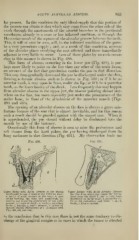Page 923 - My FlipBook
P. 923
ACUTE ALVEOLAR ABSCESS. 933
lar process. In this condition the only blood-supply that this portion of
the process can obtain is that which may come from the other side of the
tooth through the anastomosis of the arterial branches in the peridental
membrane, already in a more or less inflamed condition, or through the
Haversian canals of the septum of the alveolar process between the teeth.
This, it will at once be seen, will, in the inflamed condition of the parts,
be a very precarious supply ; and, as a result of this condition, necrosis
of the alveolar plates overlying the root afi'ected and those immediately
adjacent is very liable to occur. Loss of these plates by necrosis occur-
ring in this manner is shown in Fig. 488.
This form of abscess, occurring in the lower jaw (Fig. 489), is per-
haps more likely to point on the face than any other of the acute forms,
on account of the tact that gravitation carries the pus in that direction.
This may drop gradually down and the pus be discharged under the chin,
forming a chronic abscess such as is shown in Fig. 500 ; or if it be an
anterior tooth, it may open in front, under the lip ; or if it be a posterior
tooth, on the lower border of the cheek. Less frequently this may happen
from alveolar abscess in the upper jaw, the abscess pointing almost any-
where on the face, but more especially just under the prominence of the
malar bone, in front of the attachment of the masseter nuiscle (Figs.
490 and 495).
The opening of an alveolar abscess on the face is always a grave mis-
fortune because of the scar that is almost inevitable, and for this reason
such a result should be guarded against with the utmost care. When it
is apprehended, the pus should without delay be discharged into the
mouth by use of the bistoury.
Occasionally this form of abscess is seen to raise the periosteum and
soft tissues from the hard palate, the pus having discharged from its
bony enclosure in that direction (Fig. 491). My observation leads me
Fig. 490. Fig. 491.
Upper Molar with Acute Abscess at the Buccal Upper Incisor with Acute Alveolar Abscess
Roots and Chronic Abscess at the Palatine Root: the Pus from which has raised the Perios-
a, cavity of acute abscess in the bone h, pus- teum from the Hard Palate: a, very large
;
cavity between the bone and periosteum, ex- abscess-cavity in the bone ft, pus-cavity be-
;
tending out under the prominence of the malar twi en the periosteum and bone; c, lip; d,
process ; c, tissues of cheek ; d, tooth ; e, maxillary tooth ; e, floor of nostril.
sinus;./", nostril; c/, malar process; h, cavity of
chronic abscess discharging at i. (Compare with
Figs. 495, 496, and 504.)
to the conclusion that in this case there is not the same tendency to dis-
charge at the gingival margin as in cases in which the tumor is situated


